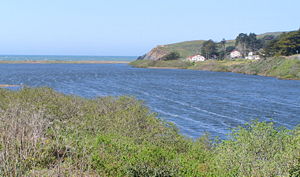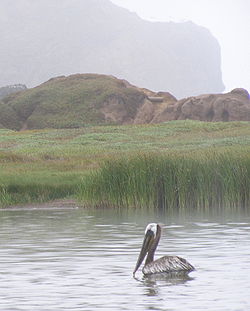
Rodeo Lagoon
Encyclopedia

Lagoon
A lagoon is a body of shallow sea water or brackish water separated from the sea by some form of barrier. The EU's habitat directive defines lagoons as "expanses of shallow coastal salt water, of varying salinity or water volume, wholly or partially separated from the sea by sand banks or shingle,...
located in the Marin Headlands
Marin Headlands
The Marin Headlands is a hilly area at the southernmost end of Marin County, California, just north of the Golden Gate Bridge. The Headlands are located just north of San Francisco, immediately across the Golden Gate Bridge. The entire area is part of the Golden Gate National Recreation Area...
division of the Golden Gate National Recreation Area
Golden Gate National Recreation Area
The Golden Gate National Recreation Area is a U.S. National Recreation Area administered by the National Park Service that surrounds the San Francisco Bay area. It is one of the most visited units of the National Park system in the United States, with over 13 million visitors a year...
, which is in southern Marin County, California
California
California is a state located on the West Coast of the United States. It is by far the most populous U.S. state, and the third-largest by land area...
. This brackish water body is separated from the Pacific Ocean
Pacific Ocean
The Pacific Ocean is the largest of the Earth's oceanic divisions. It extends from the Arctic in the north to the Southern Ocean in the south, bounded by Asia and Australia in the west, and the Americas in the east.At 165.2 million square kilometres in area, this largest division of the World...
by a sand bar that forms Rodeo Beach
Rodeo Beach
Rodeo Beach is a beach in the Golden Gate National Recreation Area located in Marin County, California, two miles north of the Golden Gate Bridge. It is characterized by a spit of around 50 meters width at the mouth of a long embayment, known as Rodeo Lagoon; for much of the year the lagoon is cut...
. Rodeo Lagoon stretches approximately 900 meters (3000 ft) by 250 meters (820 feet), and is about 2 meters (6.6 ft) deep at its maximum depth. It covers a surface area of about 15 ha (37 acres).
Inflows and Outflows
As a brackish coastal lagoon, Rodeo Lagoon contains an ever-changing mixture of freshwater and saltwater. The lagoon is fed by freshwater inflow from groundwater and from Rodeo Creek, which enters at the eastern end of the lagoon near Bunker Road. The flow from Rodeo Creek first passes through a wetlandWetland
A wetland is an area of land whose soil is saturated with water either permanently or seasonally. Wetlands are categorised by their characteristic vegetation, which is adapted to these unique soil conditions....
area known as Rodeo Lake. The "lake" does not have a significant storage volume, such that lagoon inflows are very closely linked to rainfall in the watershed. Rodeo Lagoon also occasionally receives saltwater inflow from the Pacific Ocean at times when the tidal stage and waves are high enough to overtop the sand bar. This typically occurs in the winter months, when waves are larger due to winter storms and the sand bar is lower due to erosion from lagoon outflows.

The depth, surface area, and volume of the lagoon all vary depending on the configuration of the sand berm (high or low) and rainfall (wet or dry). Depths in the center range from less than 1.5 meters (5 feet) in a dry summer to nearly 3 meters (10 feet) in a wet winter.
Tides do not have a significant effect on the circulation of water in Rodeo Lagoon. Instead, the circulation of water in Rodeo Lagoon is driven almost entirely by the wind. Since the Marin Headlands are often quite windy, it is not unusual to see Langmuir circulation
Langmuir circulation
Langmuir circulation is a wind driven helix circulation in the ocean with the axis almost parallel to the wind. Irving Langmuir discovered this phenomenon after noticing windrows of seaweed in the Sargasso Sea in 1938....
form windrow
Windrow
A windrow is a row of cut hay or small grain crop. It is allowed to dry before being baled, combined, or rolled. For hay, the windrow is often formed by a hay rake, which rakes hay that has been cut by a mower machine or by scythe into a row, or it may naturally form as the hay is mowed...
s of foam on the surface of the lagoon.
Rodeo Lagoon is a brackish water body, with salinities
Salinity
Salinity is the saltiness or dissolved salt content of a body of water. It is a general term used to describe the levels of different salts such as sodium chloride, magnesium and calcium sulfates, and bicarbonates...
in most of the lagoon ranging from 2 to 10 practical salinity units
Salinity
Salinity is the saltiness or dissolved salt content of a body of water. It is a general term used to describe the levels of different salts such as sodium chloride, magnesium and calcium sulfates, and bicarbonates...
(psu) over the course of the year. However, water near the bottom of the lagoon is often much saltier, reaching levels as high as 25 psu. The bowl-shaped bathymetry
Bathymetry
Bathymetry is the study of underwater depth of lake or ocean floors. In other words, bathymetry is the underwater equivalent to hypsometry. The name comes from Greek βαθύς , "deep", and μέτρον , "measure"...
of the lagoon traps this dense, salty water and prevents it from quickly draining back out in the ocean.

Wildlife
Rodeo Lagoon provides habitat to at least two endangered speciesEndangered species
An endangered species is a population of organisms which is at risk of becoming extinct because it is either few in numbers, or threatened by changing environmental or predation parameters...
, the tidewater goby
Tidewater goby
The tidewater goby Eucyclogobius newberryi is a goby native to lagoons of streams along the coast of California.-Taxonomy:The genus name translates as "true cycloid goby", referring to the scales, while the species epithet is in honor of J. S. Newberry. The tidewater goby is the sole member of its...
and the California brown pelican
Brown Pelican
The Brown Pelican is the smallest of the eight species of pelican, although it is a large bird in nearly every other regard. It is in length, weighs from and has a wingspan from .-Range and habits:...
. It also provides habitat to many species of migrating waterfowl. Resident fish include the threespine stickleback and prickly sculpin in addition to the tidewater goby. A family of river otters also makes frequent use of the lagoon, and includes brown pelicans in their summer diet The lagoon is ringed by emergent aquatic vegetation, such as willows and cattail, and has submerged aquatic vegetation like sago pondweed
Pondweed
Pondweed refers to many species and genera of aquatic plants and green algae:*Potamogeton, a diverse and worldwide genus*Elodea, found in North America*Aponogeton, in Africa, Asia and Australasia*Groenlandia, a genus of aquatic plants...
and widgeon grass in the shallow areas. The phytoplankton
Phytoplankton
Phytoplankton are the autotrophic component of the plankton community. The name comes from the Greek words φυτόν , meaning "plant", and πλαγκτός , meaning "wanderer" or "drifter". Most phytoplankton are too small to be individually seen with the unaided eye...
community includes diatom
Diatom
Diatoms are a major group of algae, and are one of the most common types of phytoplankton. Most diatoms are unicellular, although they can exist as colonies in the shape of filaments or ribbons , fans , zigzags , or stellate colonies . Diatoms are producers within the food chain...
s, chlorophytes, flagellated protozoa
Protozoa
Protozoa are a diverse group of single-cells eukaryotic organisms, many of which are motile. Throughout history, protozoa have been defined as single-cell protists with animal-like behavior, e.g., movement...
, Microcystis aeruginosa, and Nodularia
Nodularia
Nodularia is a genus of filamentous nitrogen-fixing cyanobacteria, or blue-green algae. They occur mainly in brackish or salinic waters, such as the hypersaline Makgadikgadi Pans, the Peel-Harvey Estuary in Western Australia or the Baltic Sea. Nodularia cells occasionally form heavy algal blooms...
spumigena. Microcystis sp. and Nodularia sp. are types of toxic cyanobacteria, capable of releasing the toxins microcystin and nodularin into the water.
Eutrophication
The population of phytoplankton described above is extremely high in the summer, a condition known as eutrophicationEutrophication
Eutrophication or more precisely hypertrophication, is the movement of a body of water′s trophic status in the direction of increasing plant biomass, by the addition of artificial or natural substances, such as nitrates and phosphates, through fertilizers or sewage, to an aquatic system...
. At times, the algae form a visible surface scum, and their high concentration results in large swings in the dissolved oxygen content of the water, culminating in a depletion of oxygen when the population finally crashes. This annual algae bloom, because of its size and potential toxicity, is considered problematic for water quality and fish survival.

Hypoxia (environmental)
Hypoxia, or oxygen depletion, is a phenomenon that occurs in aquatic environments as dissolved oxygen becomes reduced in concentration to a point where it becomes detrimental to aquatic organisms living in the system...
in the summer and fall. This deficit is caused by the high oxygen consumption of decaying algae that occurs during that time of year. The large algae population, which withdraws carbon dioxide from the water, also raises the pH to very high levels. The pH is typically greater than 9 throughout the summer algae bloom.

